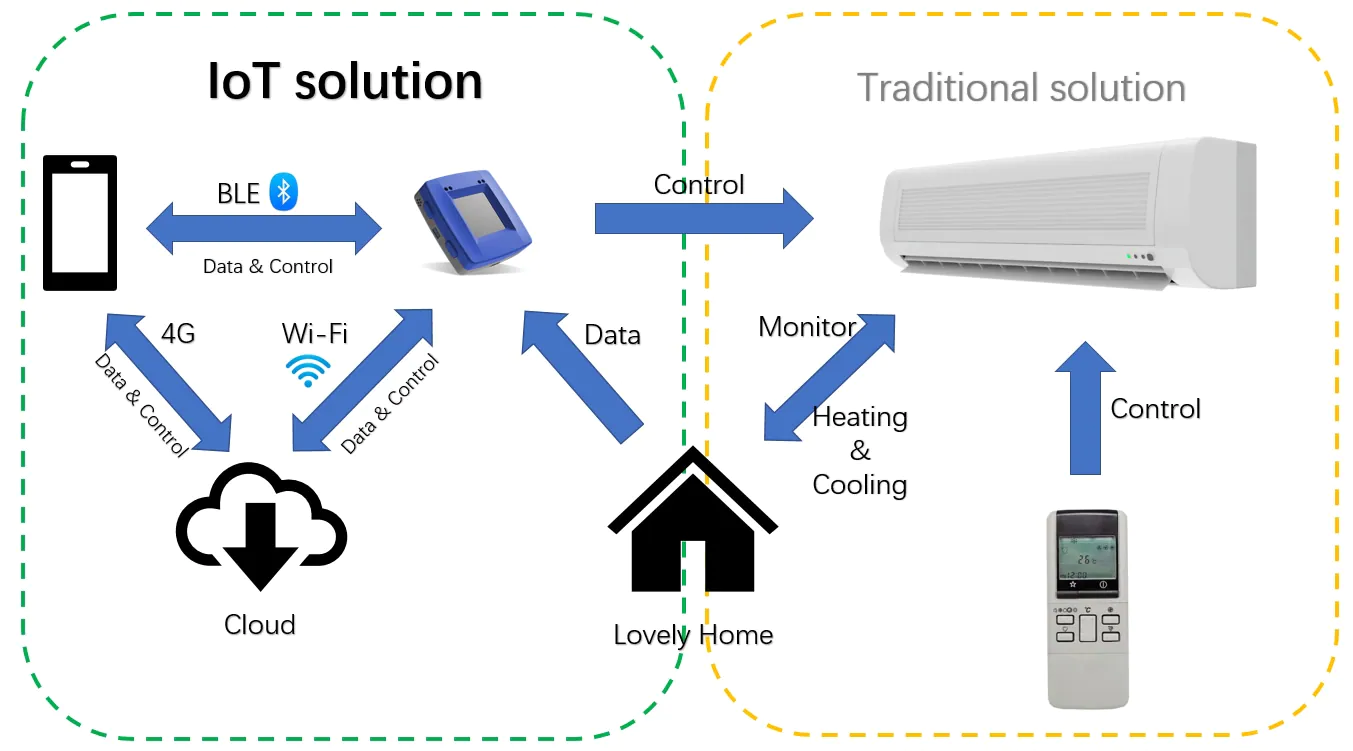Smart Thermostats
Smart thermostats are advanced devices that optimize heating and cooling in homes and buildings, leading to significant energy savings and reduced greenhouse gas emissions. These devices use internet connectivity, machine learning, and integration with building energy management systems to enhance efficiency.

Smart Thermostat Control Design w/ Rapid IoT vs Traditional AC system Control Design (NXP)
Overview
Promising breakthrough technologies for smart thermostats include:
- IoT-Enabled Thermostats: Connected to the internet, allowing remote control, precise temperature adjustments, and energy savings.
- Machine Learning: Algorithms optimize heating and cooling schedules based on usage patterns, further saving energy.
- Building Energy Management Systems: Integrate with smart thermostats, providing real-time energy feedback and enabling automatic adjustments.
- Hydropower: The most used source of renewable energy - Climate Tech Distillery
Progress Made
Smart thermostats have significantly contributed to combating climate change by automating temperature adjustments based on schedules and needs, resulting in energy savings. Studies indicate households using such thermostats can save around $180 yearly on energy bills, substantially reducing greenhouse gas emissions.
Residential Sector
Case Studies:
- Nest Labs, USA: Introduced energy-saving features like auto-away and learning algorithms (Nest Labs). Despite their popularity, the high initial cost can be a barrier for some consumers.
- ecobee, Canada: Developed smart thermostats with room sensors to optimize comfort and energy use (ecobee). The company faces competition from other major players in the market.
- Honeywell, USA: Offers a range of smart thermostats and building energy management systems (Honeywell). While effective, the integration with existing systems can be complex and costly.
Commercial Sector
Case Studies:
- 75F, USA: Uses smart sensors and controls to make commercial buildings healthier, more comfortable, and more efficient (75F). The technology is promising but requires significant investment for widespread adoption.
- Johnson Controls, USA: Provides smart thermostat solutions for commercial buildings to optimize energy use (Johnson Controls). The company faces challenges related to retrofitting older buildings.
- Schneider Electric, France: Integrates smart thermostats with building management systems to enhance energy efficiency (Schneider Electric). The scalability of their solutions remains a challenge.
Industrial Sector
Case Studies:
- Siemens, Germany: Implements smart thermostat solutions in industrial settings to optimize heating and cooling (Siemens). The integration with existing industrial systems can be complex and costly.
- ABB, Switzerland: Provides smart thermostat solutions for industrial applications to improve energy efficiency (ABB). The company faces competition from other major players in the market.
- Emerson, USA: Develops smart thermostat solutions for industrial environments to enhance energy management (Emerson). The scalability of their solutions remains a challenge.
Lessons Learned
Key lessons from smart thermostats' development:
- Open Platform Importance: An open platform's success enables various entities to develop applications, fostering diverse product offerings and higher adoption rates.
- User-Friendly Interfaces: Simplified interfaces enhance adoption rates by making devices more accessible.
- Data Comprehensiveness: Accurate energy consumption data is essential for effective device use and informed energy decisions.
- Partnership Significance: Collaboration with utilities and manufacturers ensures widespread and effective adoption.
- Ongoing Support Necessity: Continuous support and training post-adoption optimize benefits.
Challenges Ahead
Challenges in smart thermostats' development and implementation:
- Lack of Awareness: Wider public awareness is needed about the technology's benefits to encourage adoption.
- Cost: The relatively high cost deters many from investing in smart thermostats.
- Lack of Coordinated Effort: A unified effort is lacking in promoting and implementing smart thermostats.
- Technical Integration: Integrating smart thermostats with older HVAC systems can be challenging and costly.
Best Path Forward
Mitigating climate change requires reducing greenhouse gas emissions. Smart thermostats can help by optimizing heating and cooling, lowering energy consumption. To ensure wide-scale adoption and effectiveness, public education, affordability, and user-friendliness are crucial.
Key Steps:
- Public Awareness: Increase awareness about the benefits of smart thermostats through education and outreach efforts.
- Affordability: Implement financial incentives and rebates to lower the initial cost barrier.
- User-Friendly Design: Develop intuitive interfaces to enhance user experience and adoption rates.
- Policy Support: Encourage governments and businesses to adopt and promote smart thermostat technologies.
- Research and Development: Support ongoing R&D to improve smart thermostat technologies and integration capabilities.
Prominent supporters include the Environmental Protection Agency, the Alliance to Save Energy, and Nest Labs.
Image credit: NXP